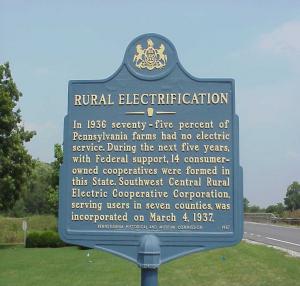
History of Electric Cooperatives – An American Story
What Exactly is an Electric Cooperative?
Co-ops were developed to fill a need not addressed by other kinds of businesses, such as single owner, partnership, and investor-owned.
One of every four Americans is a member of a cooperative. Even if you’re not a co-op member, you still depend on cooperative businesses for essential products and services.
Many articles in your daily newspaper may be labeled “Associated Press” or “AP”. These stories were written by individual reporters but distributed by a cooperative news organization. Some of the bigger cooperatives include Sunkist, Land O’ Lakes, Ocean Spray, Agway, and the list goes on. The largest co-op class in the nation is your credit union, serving more than 48.5 million members.
Our Guiding Principles
Seven guidelines called “The Rochdale Principles” have been established. Without these principles, the cooperative movement, which now serves 60 million people in the United States and 200 million people worldwide, may not exist.
The History
Take a minute and imagine what your life would be like without electricity. Then think about what rural areas throughout Pennsylvania must have been like without electricity 75+ years ago. Before 1935 electricity was available only to people who lived in or near cities or larger towns. In fact many people believed that farm families did not want - or even need - electricity. Things began to change rapidly, however, when President Franklin D. Roosevelt signed an executive order on May 11, 1935, creating the Rural Electrification Administration (REA), a branch of the U.S. Department of Agriculture charged with lending money to help get electricity to rural areas. Private companies could see little profit in rural areas. It wasn't long before neighbors joined together to create nonprofit cooperatives in their area; cooperatives could borrow money from REA to build electrical systems. The following is an excerpt from the book Miracle Blessing - Rural Electrification in Pennsylvania, originally published in 1977:
It was dark. It was cold and dreary. Life consisted of one gut-wrenching dawn-to-dusk day after another. Life was hard in rural America. Those who lived on the farms eked out a bare existence at best. At worst, they were forced from the land to join the unemployed in lines for food and stood in lines hoping for the few factory jobs which might offer hope for existence and a chance to regain the pride of self-sufficiency. Life in rural Pennsylvania without electric power was a series of never ending tasks, all performed by hand; the back-breaking labor of chopping wood, hauling ashes and water, emptying the slop bucket, filling the kerosene lamps, wick trimming, globe polishing. There was no T .V ., no lights, electric motor, electric heat, air conditioning, cooking, freezing, hot water…
REA Energy was originally incorporated on March 4, 1937, as Southwest Central Rural Electric (SCRE). On May 1, 2001, the cooperative officially changed its name to REA Energy Cooperative, Inc. (REA). REA serves rural areas in Armstrong, Blair, Cambria, Clearfield, Indiana, Jefferson, and Westmoreland counties. REA is owned by consumer-members and governed by a board of directors elected by the membership. Click here to read a story on the origins of REA Energy.
REA Energy then, REA Energy now
| 1976 | 2023 | ||
| Number of Members | 14,404 | Number of Services | 25,347 |
| Miles of Line | 1,998 | Miles of Line |
2,731 |
| kWh Purchased | 174,500,465 | kWh Sold | 370,745,390 |
| Full-Time Employees | 54 | Full-Time Employees | 68 |

